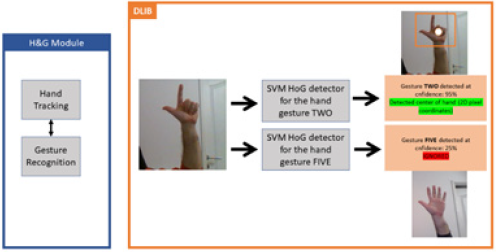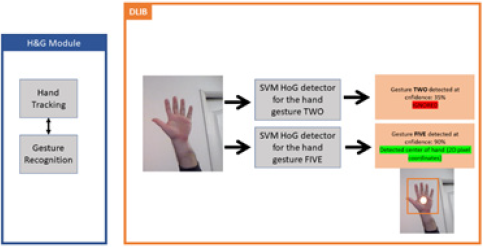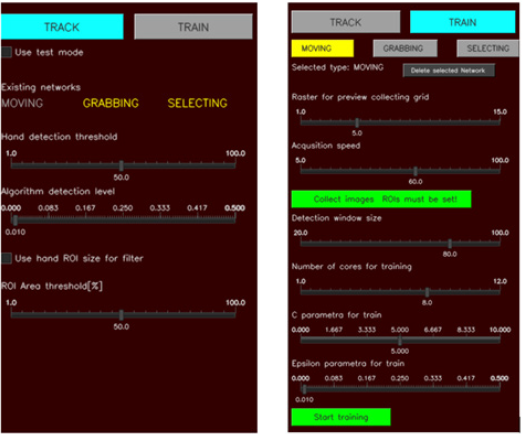- Submissions

Full Text
Trends in Telemedicine & E-health
Hand and Gesture Module for Enabling Contactless Surgery
Martin Žagar1*, Alan Mutka1, Ivica Klapan2,3,4 and Zlatko Majhen5
1RIT Croatia, Croatia
2Klapan Medical Group Polyclinic, Croatia
3School of Medicine, Croatia
4School of Dental Medicine and Health, Croatia
5Bitmedix, Croatia
*Corresponding author: Martin Žagar, RIT Croatia, Croatia
Submission: August 27, 2021; Published: September 24, 2021

ISSN: 2689-2707 Volume 3 Issue 1
Abstract
Nowadays, there are many new approaches and techniques in telemedicine and surgery with different kinds of innovations and a growing need for contactless control of surgery parameters. Our proposal is aiming to resolve the problem of standard surgical parameters with gesture-controlled surgical interventions. We designed a contactless interface as a plug-in application for the DICOM viewer platform using a hardware sensor device controller that supports hand/finger motions as input, with no hand contact, touching, or voice navigation. Our proposed approach enables surgeons to get complete and aware orientation in the operative field (which currently isn’t the case and where the problem lies), where ‘overlapping’ of the real and virtual anatomic models is inevitable. Human mind and understanding of this new surgery work by creating entirely new models of human behavior and understanding spatial relationships, along with devising assessment that will provide an insight into our human nature. That’s why the essential part of our solution is to build the adequate hand and gesture module for motion which we will describe in this paper.
Keywords: Contactless surgery; Hand and gesture module; Motion tracking; Spatial relationships
Introduction
Motion tracking enables more precise virtual movement, rotation, cutting, spatial locking,
and measuring as well as slicing through datasets. To provide the most immersive experience,
we use a camera for depth and motion tracking that has active stereo depth resolution with
precise shutter sensors for depth streaming with a range up to 2-3 meters which is essential
in the OR and which gives a sense of freedom to the surgeon during the surgery. That’s why
we approached the design of this part of the solution with special care to build an accurate,
but still an intuitive and straightforward way of activating positioning control which is based
on waiting for the users’ hands to enter the central trigger area to activate the interaction
with the interface, with touch-free surgeon’s commands. We intend to offer an alternative
to closed SW systems for visual tracking and develop the SW framework that will interface
with depth cameras and provide a set of standardized methods for medical applications
such as hand gestures and tracking, face recognition, navigation, etc. We found it possible
to significantly simplify movement gestures in the virtual space of virtual endoscopy. Our
clinical and technology research is already at the high maturity level of accomplishing the
proof-of-concept phase. Our clinical tests and technological achievements where we already
tested our previous solution with Leap Motion in OR are demonstrated in the results of several
research papers [1-3]. After updating the needs in clinical workflow based on the inputs from
several different medical specialists, we now identified two primary tasks for the hand and
gesture module for motion tracking. For the part of hand tracking, it is important to provide
hand coordinates in two dimensions and surrounding in 3D. For the gesture recognition and
tracking part of the module, we designed gesture states based on the hand tracking.
The rest of the paper presents an overview of the possible
solution we have tested with advantages and disadvantages. In the
end, the two best solutions for our application are selected and
implemented in the final software explication, where we will show
the results in the Results section.
Hand and Gesture Module Implementation and Results
All algorithms from the previous section were implemented
and tested, and we have selected two of them in the final
implementation:
a) DLIB - very fast on a regular CPU computer, easy to train.
Since we have constant lighting conditions in OR, the model can
be trained in several minutes, and it is ready for usage.
b) MediaPipe Hands - pre-trained R-CNN models for hand
detection - there is no need for additional training.
DLIB implementation
DLIB approach consists of three phases: Acquisition, learning,
and a detection phase. The learning phase requires gathering up to
100 images of the hand, showing the specific gesture. For example,
Figure 1. shows the sliding window image acquisition principle.
First, the region of interest needs to be selected by the user (the
orange rectangle). Second, the approximated hand region is also
manually selected (the green rectangle). Once the regions are
chosen, the algorithm dynamically repositions the rectangle, and
the user needs to follow it by placing their hand exactly inside the
movable green rectangle. The result is up to 100 images of hands
inside the region of interest.
After the acquisition is finished (for example, the open hand
or FIVE gesture), the learning algorithms generates an SVM model
saved in a dedicated file - FIVE.svm. The whole procedure needs to
be repeated for all other gestures. Our project controls the DICOM
viewer application only with two gestures (FIVE and TWO). As a
result, the training and learning phase generate two files: FIVE.svm
and TWO.svm, which are then used in the third detection phase.
The final detection phase is shown in Figure 2 & 3. The input
image is processed in parallel with both detectors (FIVE and TWO
models). The detected hand center (2D pixel coordinates) as output
is provided if one detectors’ confidence is more significant than
the predefined threshold Figure 2 shows the result when the input
hand gesture is TWO, while Figure 3 shows the result of gesture
FIVE.
Figure 1: Sliding window image acquisition.

Figure 2: Final detection with gesture TWO.

Figure 3: Final detection with gesture FIVE.

The implemented DLIB algorithm provides up to 20 FPS hand/
gesture detection, mostly depending only on the CPU power. The
algorithm’s output are:
a. Center of hand in 2D Image Pixel coordinates
b. Center of hand in 3D world/camera coordinates
c. Hand gesture (the gesture must be learned during the
learning phase).
DLIB implementation in the developed software is presented in
Figure 4. There exists two tabs: TRACK and TRAIN tab.
The TRAIN tab consists of the following properties/parameters:
a. MOVING, GRABBING and SELECTING - the general Gesture
States naming (more explained later)
b. Raster for preview collection grid - sliding window raster,
greater number more images will be acquired
c. Acquisition speed - the acquisition time between two
acquired pictures for training - less number, faster acquisition
d. Collect images, ROIs must be set - this button starts the
acquisition process
e. Detection window size, number of codes for training,
C parameter for training, Epsilon parameter for training -
parameters for DLIB learning phase
f. Start training - button to start the training/learning phase.
The training phase needs to be repeated for every general
Gesture State (moving, grabbing, and selecting). As a result, three
trained models are saved, and the software is ready for the track/
detection phase within the TRACK tab. The TRACK tab consists of
the following properties/parameters:
a. Hand detection threshold - the confidence threshold -
lower value, less restriction, more stable detection
b. Algorithm detection level
c. ROI area threshold.
Figure 4: DLIB software implementation - training and track tab.

Conclusion
Whether surgery is planned or urgent, it is always marked by interdisciplinarity with a very strong dependence on the individual expertise of surgeons, anesthesiologists, and other medical staff. Working in team conditions, the surgical procedure is often marked by time pressure and consequently stress. Therefore, operating theaters are also considered high-risk sites prone to errors and surgical complications. In the process of medical data visualization during the surgery, it is important enabling a precise and fast solution for contactless surgery where we built our solution for hand and gesture tracking with the main benefits interactor features in selecting and grabbing:
Selecting
By using a gesture TWO and moving hand UP-DOWN, the user
changes the DICOM control modes
a) NONE - none of the modes if selected
b) HU_CENTER - changing the center parameter of the CT’s
Hounsfield scale
c) HU_WINDOW - changing the window parameter of the
CT’s Hounsfield scale
d) VOLUMEN_OPACITY - changing the volume opacity
e) PLANE_OPACITY - changing the opacity of the measuring
plane
f) CAMERA_YAW_PITCH - changing the scene’s camera
position in XYZ world
g) SLICES_XYZ - changing the measurement planes in XYZ
world
h) SLICES_XYZ_M1 - changing the measurement planes in
XYZ world with setting the measurement point M1
i) SLICES_XYZ_M2 - changing the measurement planes in
XYZ world with setting the measurement point M2.
Grabbing
By using a gesture FIVE and moving LEFT-RIGHT, for each mode the parameters can be changed. All parameters are changes by moving the hand LEFT-RIGHT, except for the CAMERA and SLICES modes where LEFT-RIGHT, UP-DOWN, and the Z-axis are included (towards the camera) are included.
With these features, a surgeon is able to control the DICOM Viewer scene and to enable fully contactless medical data visualization during the surgery.
Acknowledgment
This work is funded by European Institute for Innovation and Technology, EIT Innostars Health grant.
Conflict of Interest
We declare that we have no conflict of interest.
References
- Klapan I, Majhen Z, Žagar M, Klapan L, Trampuš Z, et al. (2019) Utilization of 3d medical imaging and touch-free navigation in endoscopic surgery: Does our current technologic advancement represent the future innovative contactless noninvasive surgery in rhinology? What is next? Biomedical Journal of Scientific & Technical Research 22(1): 16336-16344.
- Klapan I, Duspara A, Majhen Z, Benićl I, Trampuš Z, et al. (2019) Do we really need a new navigation-noninvasive “on the fly” gesture-controlled incisionless surgery? Biomedical Journal of Scientific & Technical Research 20(5): 15394-15404.
- Klapan I, Duspara A, Majhen Z, Benić I, Kostelac M, et al. (2017) What is the future of minimally invasive surgery in rhinology: Marker-based virtual reality simulation with touch-free surgeon’s commands, 3D-surgical navigation with additional remote visualization in the operating room, or ...? Frontiers in Otolaryngology-Head and Neck Surgery 1(1): 1-7.
- Cao Z, Hidalgo G, Simon T, Wei S, Sheikh Y (2019) OpenPose: Realtime multi-person 2d pose estimation using part affinity fields. Proceedings of IEEE Computer Society Conference on Computer Vision and Pattern Recognition, San Juan, USA, pp. 7291-7299.
- https://github.com/CMU-Perceptual-Computing-Lab/openpose
- https://www.learnopencv.com/training-a-custom-object-detector-with-dlib-making-gesture-controlled-applications
- Viola p, Jones MJ (2001) Rapid object detection using a boosted cascade of simple features. IEEE Computer Society Conference on Computer Vision and Pattern Recognition, San Juan, USA, pp. I-I.
- https://docs.openvinotoolkit.org/latest/index.html
- https://software.intel.com/content/www/us/en/develop/tools/openvino-toolkit/pretrained-models.html
- https://google.github.io/mediapipe/solutions/hands
© 2021 Martin Žagar. This is an open access article distributed under the terms of the Creative Commons Attribution License , which permits unrestricted use, distribution, and build upon your work non-commercially.
 a Creative Commons Attribution 4.0 International License. Based on a work at www.crimsonpublishers.com.
Best viewed in
a Creative Commons Attribution 4.0 International License. Based on a work at www.crimsonpublishers.com.
Best viewed in 







.jpg)






























 Editorial Board Registrations
Editorial Board Registrations Submit your Article
Submit your Article Refer a Friend
Refer a Friend Advertise With Us
Advertise With Us
.jpg)






.jpg)














.bmp)
.jpg)
.png)
.jpg)










.jpg)






.png)

.png)



.png)






